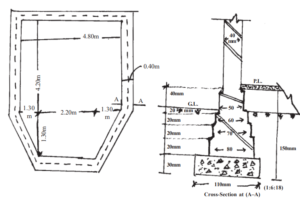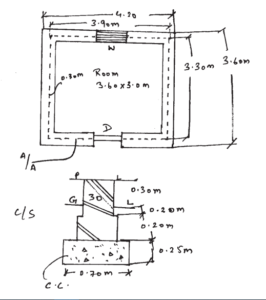Important RGPV Question
Table of Contents
ToggleCE- 503 (C) Quantity surveying & Costing
V Sem, CE
UNIT 1-Introduction
Q.1) Prepare a preliminary estimate of multi-storied office building having carpet area of 2,200 sq.m. 35% the building area will be taken up by corridors, verandah, laboratory, staircase etc. and 10% of the built up area will be occupied by walls. Assume plinth area rate to be Rs. 6000/- per sq.m and also provide for Water supply, Sanitary fittings and Electric installations, Contingencies and other services.
(RGPV June 2020)
Q.2) Explain factors to be considered while preparing detailed estimate.
(RGPV June 2020)
Q.3) Calculate the following items from the plan and section given below in following figure using centre line method.
a) Excavation for foundation
b) Cement concrete (1:6:18) in foundations
c) Brick work in cement mortar (1:6) in foundation and plinth
(RGPV June 2020)

Q.4) Prepare a preliminary estimate of a four storied office building having total carpet area of 2000.sq.m for obtaining the administrative approval of the government, given the following data. It may be assumed that 40% of the built up area will be taken up by corridors, verandah, lavatories, staircase etc.
Plinth area rate is Rs. 1325/-per sq.m
Extra for special architectural treatment 0.5% of building cost.
Extra due to deeper foundation at site 1% of building cost.
Extra for water supply and sanitary installation 8% of building
cost.
Extra for internal electrical installation 12.5% of building cost.
Extra for other services 5% of building cost. Contingencies –
2.5% supervision charges – 10%.
(RGPV Dec 2020)
Q.5) What is the principle of units for various items of works in estimation?
(RGPV Nov 2023)
Q.6) Differentiate between revised and supplementary estimate.
(RGPV Nov 2023)
Q.7) Explain the procedure for the preparation of a Detailed Estimate.
(RGPV Nov 2023)
UNIT 2-Rate Analysis
Q.1) Explain long wall and short wall method with an example.
(RGPV June 2020)
Q.2) Workout from the first principle the rate analysis for :
i) 12 mm thick plastering for superstructure
ii) PCC (1:3:6) for foundation using 20 mm and down
size aggregates.
(RGPV June 2020)
Q.3) Work out the rate analysis for:
i) Plain cement concrete 1:1.5:3
ii) Plastering 12mm. and 20mm. thick with a proportion
of (1:5) cement mortar.
(RGPV Dec 2020)
Q.4) Explain the following:
i) CSR
ii) Factors involved in the rate analysis of an item.
(RGPV Dec 2020)
Q.5) What are the various factors affecting the rate analysis?
(RGPV Nov 2023)
Q.6) Estimate the quantities of brickwork and plastering required in a wall 4 m long. 3 m high and 30cm thick. Calculate also the cost if the rate of brickwork is Rs. 320 per cu. m and of plastering is Rs. 8.50 per sq m.
(RGPV Nov 2023)
Q.7) Prepare the rate analysis for lime concrete in foundation with 40 mm down brick ballast, lime and surkhi proportional 1:2:6.
(RGPV Nov 2023)
UNIT 3-Detailed Estimates
Q.1) List out the various types of roads. Mention the various parts of a gravel road.
(RGPV June 2020)
Q.2) List out the various types of engineering works involving
earthwork.
(RGPV Dec 2020)
Q.3) Calculate the quantity of earthwork for 200 meter length for a portion of a road in a uniform ground. The heights of the banks at the two ends are 1.00 and 1.60m. The formation width is 10 meter and side slopes are 2:1. Assume that there is no transverse slope.
(RGPV Dec 2020)
Q.4) Explain mid-sectional area method of calculating the quantity of carthwork for road estimating.
(RGPV Nov 2023)
Q.5) Fig. shows the plan and cross-section for a wall 5 metre in length. Prepare quantity estimate for the following items- i) Earthwork in excavation in foundation ii) Lime concrete in foundation iii) 1st class brickwork (1:4) in foundation and plinth iv) 1 class brickwork (1:6) in superstructure wall v) 2.5 cm thick DPC (1:2:4) with water proofing compound.

(RGPV Nov 2023)
UNIT 4-Cost of Works
Q.1) Carry out the rate analysis for :
i) Brick work in cement mortar (1:6) using standard size of bricks.
ii) 20 mm thick DPC with cement mortar 1:5 (1:6)
(RGPV June 2020)
Q.2) What is DPR? Discuss the content of DPR in detail.
(RGPV June 2020)
Q.3) Explain the following terms- i) Overhead charges ii) Work charge establishment iii) DPR and its preparation
(RGPV Nov 2023)
UNIT 5-Valuation
Q.1) Write down the methods for calculating depreciation and explain any one with example.
(RGPV June 2020)
Q.2) A government accommodation is built at the cost of Rs. 6,00,000/-. The water supply, sanitary and electrical installation expenditure is Rs. 15000/-. Calculate the standard rent of the building if the following rate of return is fixed.
i) 6% on construction cost
ii) 1% towards maintenance of building work
iii) 4% on installation expenditure
iv) 4% on maintenance of installation
v) Rs. 120/- as property tax per year
vi) Cost of land is be neglected.
(RGPV June 2020)
Q.3) A building costing Rs. 3,50,000/- has recently been constructed in a big city. The plot measuring 450 sq. m was purchased @ Rs. 150/- per square meter. Work out the rent of the property. Assume 8% as net return on the cost of the construction and 4% on the land value. All expected outgoing are Rs.10,000/-per year.
(RGPV Dec 2020)
Q.4) Explain Sinking fund method.
(RGPV Dec 2020)
Q.5) What are the various purpose of valuation. Explain in detail.
(RGPV Dec 2020)
Q.6) What is Year’s Purchase (Y.P.)? Work out the value of year’s purchase for an old building if its future life is 15 years and the rate of interest is 7% on capital and 4% for sinking fund.
(RGPV Nov 2023)
Q.7) Differentiate between- i) Scrap Value and Salvage Value ii) Market Value and Book Value.
(RGPV Nov 2023)
Q.8) Define Sinking Fund. Explain how it is determined?
(RGPV Nov 2023)
Q.9) Differentiate between Value, Cost and Price. What is Valuation? What is the function of a Valuer?
(RGPV Nov 2023)
EXTRA QUESTIONS-
Q.1) Explain long wall and short wall method with an example.
(RGPV June 2020)
Q.2) The areas within the contour line at the site of reservoir and
the proposed face of the dam are as follows :

Taking 101 as the bottom level of the reservoir and 109 as the top level, calculate the capacity of the reservoir.
(RGPV June 2020)
Q.3) Find out the quantity of masonry work in a segmental arch of clear span 3.5 m and rise of 1.5 m, the thickness of the arch ring is 40 cm and wall width is 40 cm.
(RGPV June 2020)
Q.4) Write shorts notes on-
i) Scrap value
ii) Salvage value
iii) Overhead charges
iv) Mid Sectional Area Method
(RGPV June 2020)
Q.5) Calculate Excavation for foundations, Cement Concrete and Brick Work in mud mortar in foundations, up to plinth level, using center line, Crossing and Out to out and in to methods.
(RGPV Dec 2020)

Q.6) Find out the quantity of masonry work in a segmental arch of clear span 3.5m and rise of 1.5m the thickness of the arch ring is 40cm and wall width is 40cm.
(RGPV Dec 2020)
Q.7) Explain Mid sectional area method with an example.
(RGPV Dec 2020)
Q.8) Write short notes on
a) Scrap value
b) DPR
c) Overhead charges
d) Factors affecting cost of work
(RGPV Dec 2020)
— Best of Luck for Exam —
